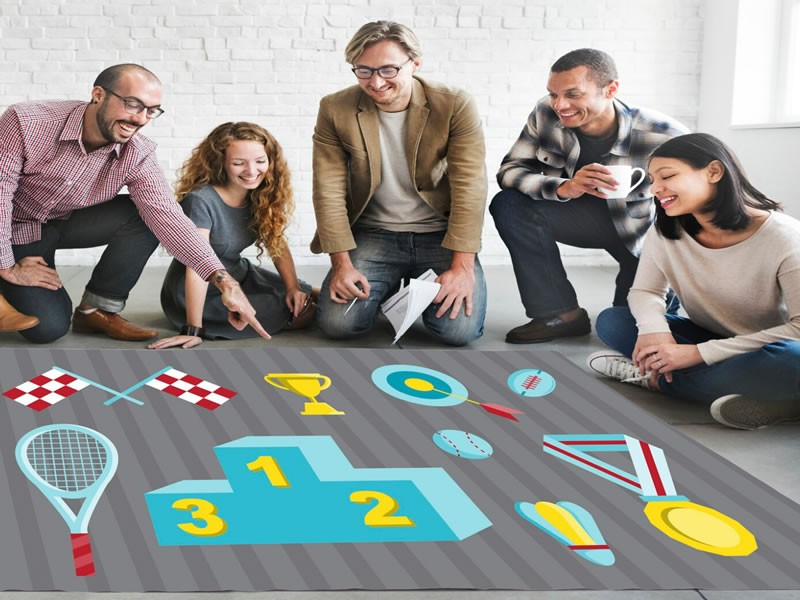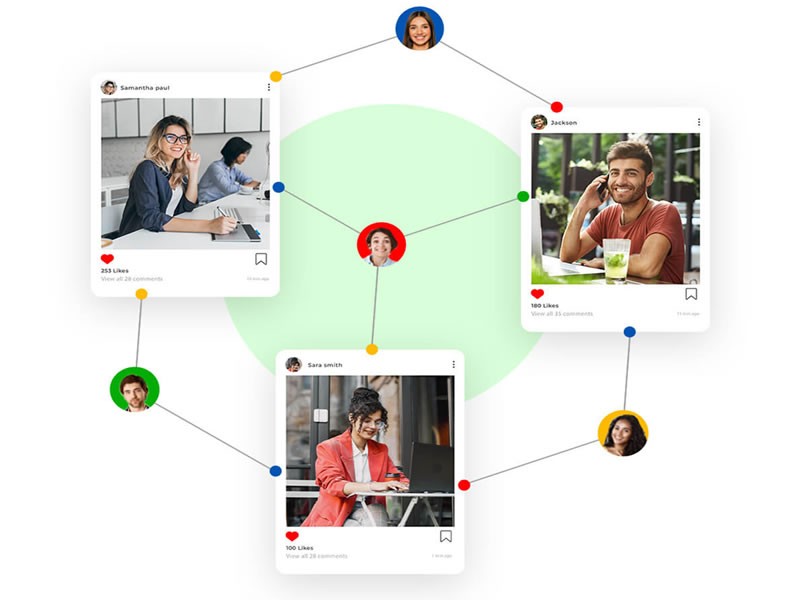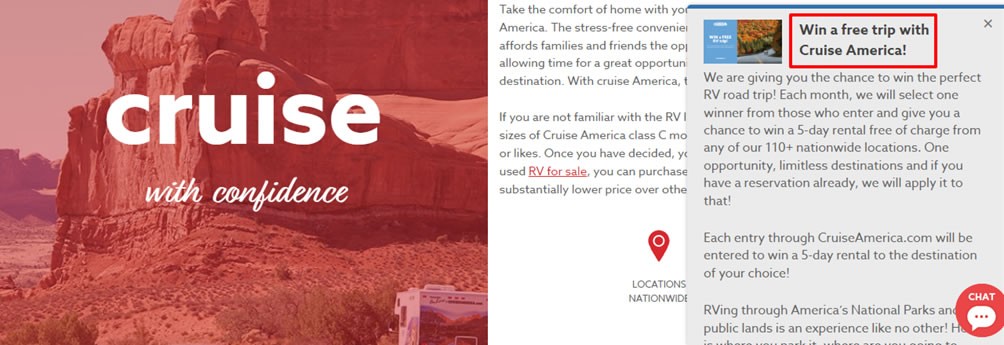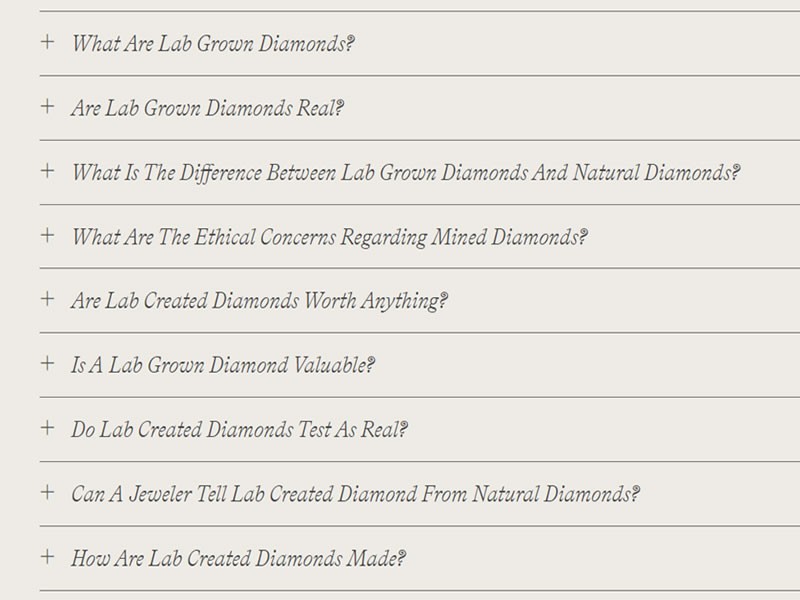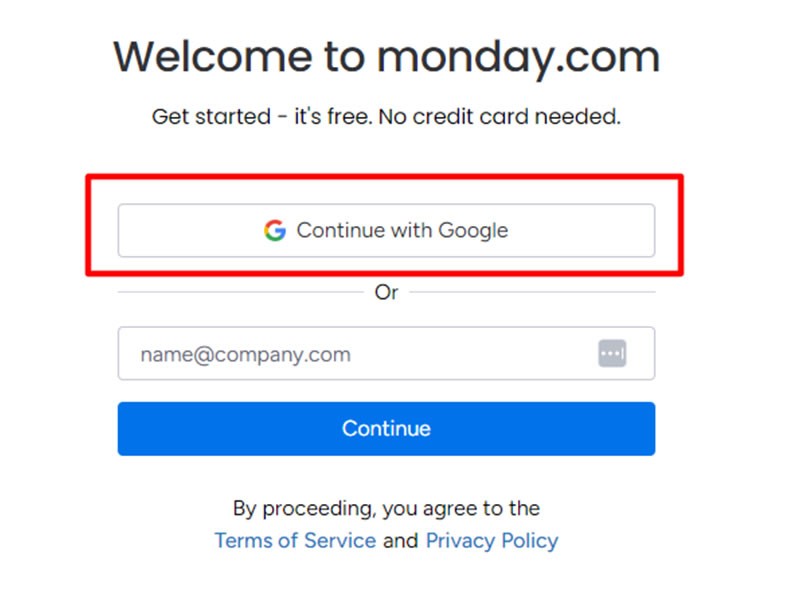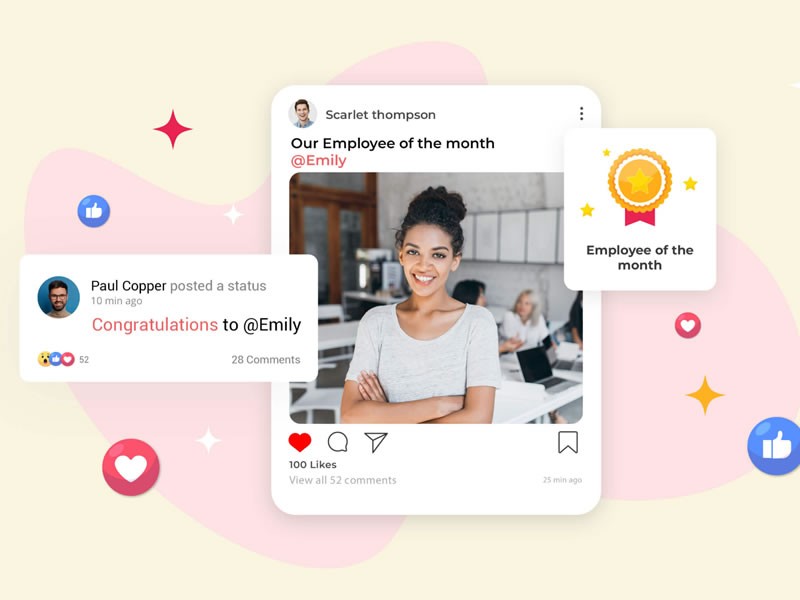Insight Blog
Agility’s perspectives on transforming the employee's experience throughout remote transformation using connected enterprise tools.
12 minutes reading time
(2360 words)
How to Design and Implement a Gamified Employee Engagement Program: A Step-by-Step Guide
Learn how to design and implement a gamified employee engagement program: A step-by-step guide
Looking to deliver better employee experiences?
Don't overlook the power of using gamification for employee engagement.
Being part of a team can feel rewarding. But it can also feel isolating and lonely.
When colleagues don't have time to bond or interact, it can create a divide between them and the companies they work for.
Employees who mingle with coworkers and get recognized for their contributions have the opportunity to feel like they're part of a more meaningful organization.
In this article, we're taking a closer look at what gamification is and what a gamified employee engagement program might look like. We'll also go over five simple steps you can take to create a gamified employee engagement program for your organization.
Let's get started.
What is gamification?
Gamification means applying game elements and mechanics in non-game contexts to engage and motivate people, typically in areas such as education, marketing, and business.
Gamification adds a layer of playfulness to otherwise mundane tasks or processes by incorporating elements like competition, points, levels, challenges, and rewards.
Whether it's earning points for completing tasks, unlocking rewards for achieving milestones, or competing with others for the top spot on a leaderboard, gamification can:
- Enhance employee engagement
- Foster learning and skill development
- Encourage desired behaviors
- Drive desired business outcomes
What is a gamified employee engagement program?
Let's paint a vivid scene: you, the spirited conductor of internal communications, orchestrating a symphony of joy by bringing gamification into our workplace. It's not just about tasks; it's about infusing delight, uplifting spirits, and creating connections that resonate.
Picture the magic of Trivia Tuesdays—a blissful hour every week where our team immerses themselves in the core of our brand values and mission statement. Envision the excitement, the shared laughter, and the elation of victory as our most engaged colleagues claim their well-deserved prizes.
Can you feel the pulsating energy? The camaraderie that binds us together? If this sounds like the kind of exhilarating joy that our team hungers for, then delve into the realm of gamification at work. It's not merely a concept; it's a promise of shared laughter, deep engagement, and a workplace where enthusiasm thrives. So, join us on this adventure, and let's turn our workplace into a haven of joy and triumph.
Because when work becomes a source of joy, the extraordinary happens.
A gamified employee engagement program is a strategy that uses game elements to increase employee participation, motivation, and satisfaction within the workplace.
It involves implementing a system that rewards employees for their achievements and encourages them to actively engage in tasks and goals.
These programs may include challenges, competitions, leaderboards, badges, and rewards to foster a sense of healthy competition and recognition.
By gamifying employee engagement, organizations can create a more stimulating and enjoyable work environment, increase productivity, foster collaboration, and boost employee morale.
Now that we're clear on the basics, let's take a look at how to design and implement a gamified employee engagement program:
Benefits of gamification
Unlocking the magic of gamification is like discovering a treasure chest of learning potential.
Imagine vibrant interactive visuals and playful infographics as your trusty companions, guiding you through a journey where knowledge isn't just acquired; it's embraced and retained with three times the impact.
- Engaging Visuals as Learning Companions: Visualize a world where learning is not a monotonous trek but an adventure filled with interactive visuals. Whether it's dynamic graphics or captivating infographics, these companions breathe life into information, making it stick in our minds with a lasting resonance. It's like having a supportive friend on your learning quest, turning even the most complex concepts into a visual feast of understanding.
- The Joyful Symphony of Interactive Learning: Feel the heartbeat of joy as gamification transforms the study journey into a symphony of interactive delight. It's not just about absorbing facts; it's about actively engaging with the material in a way that sparks curiosity and enjoyment. Picture a world where learning isn't a chore but a thrilling dance of exploration, making every lesson an adventure waiting to be embraced.
- Pacing that Resonates with Comfort: Picture a learning environment where the rhythm of understanding is set by you. Gamification isn't just a tool; it's a pace-setter that allows students to comfortably process information. It's the key to overcoming the hurdle of disinterest by tailoring the learning experience to individual preferences. With gamification, the journey of knowledge unfolds at a tempo that feels like a comfortable stroll rather than a frantic sprint.
In this world of gamified learning, information isn't just retained; it's cherished.
It's a journey where engagement isn't forced but invited, and where the pursuit of knowledge becomes a thrilling adventure with visuals, interactivity, and a pace that resonates with the beat of your own learning heart.
Design and Implement a Gamified Employee Engagement Program
Step 1: Consider core employee and company needs
Start by assessing employee and company-specific needs to help inform your employee engagement plan.
This is crucial to having a gamified employee engagement program that's effective, fosters a positive working environment, and sets your company apart from the competition.
For instance, if one of your company's goals is to lower employee turnover and boost employee morale, then you might consider polling or surveying your employees to uncover their values and priorities.
Use this feedback to shape your program and rewards.
For instance, if your team members state that creative training opportunities help boost employee productivity, then you might consider offering ongoing gamified training experiences.
Or if they state that the workload is heavy and they'd appreciate more time off, you might consider offering them the chance to "win" paid time off.
Step 2: Choose your gamified experiences and offer "game breaks" to encourage creative thinking and team building
Choose employee gamification activities in line with your company culture, core business and employee needs, and long-term business goals.
Offer employees the chance to play these games during designated game breaks.
Here are some ideas to inspire you:
Go old-school by offering breaks to play group video games or online PC games line an online chess game.Integrating online PC games into your corporate engagement strategies can do more than just entertain —it can transform how your team interacts, collaborates, and stays motivated.
Much like a well-crafted game immerses players in its world, bringing gaming into the workplace can deeply engage employees, fostering a sense of community and shared achievement.
Games like strategy simulations or team-based challenges not only offer a fun escape but also mirror workplace scenarios requiring teamwork, problem-solving, and decision-making skills.
Introducing these games as part of team-building activities or regular "game breaks" can be a great way to shake off workplace monotony, encourage creative thinking, and build a stronger, more connected team.
They provide a common ground where employees from different departments or levels can interact in a relaxed and enjoyable setting, leveling the playing field and promoting open communication.
You might also consider offering prizes to winning teams, such as gaming skins and add-ons, like Catwoman's grappling claw for Fortnite gamers, or the chance to earn "cash" or gift cards to purchase more video games and digital goods.
Follow us and access great exclusive content everyday: Follow us on Google News
Gamify the remote work model
Give remote employees a chance to step away from their desks to earn points during designated "game times."
Give remote employees a chance to step away from their desks to earn points during designated "game times."
Consider offering breaks that encourage team members to go for walks, nourish themselves, or explore new places.
You could offer a different point range for each activity and offer prizes to employees with the most points at the end of each quarter.
For example, employees could earn 100 points if they eat a healthy meal, 150 points if they go for a 20-minute walk, and 250 points if they explore unique spots in their cities. Just have them take a photo of the experience they chose.
You could also collaborate with local vendors or travel partners to reward your high achievers. For instance, you could partner with an RV rental company in Los Angeles to reward LA-based employees.
By partnering with the right companies, you could offer prestigious prizes, such as:
- Booked RVs for the weekend
- Massages and facials at a local spa
- Gift cards to a local steak restaurant
Stays at an Airbnb outside of the city.
Host quiz-based competitions and other game-based learning initiatives
Foster healthy competition and test employee knowledge by hosting team question-and-answer games.
Consider hosting quiz-based competitions at company mixers, during team meetings, or on long workdays.
These not only give employees a chance to unwind with colleagues but also provide training experiences — an essential benefit for companies with luxury or complex offerings.
High-end and complex offerings, whether they're exquisite diamond jewelry, fine-crafted clothing, or data center sustainability, require a deep understanding and appreciation of their unique qualities.
When employees have the opportunity to test their knowledge of these products and services, it helps them better grasp the craftsmanship, quality, and behind-the-scenes processes that go into creating these offers.
As a result, team members become more than just employees. They transform into brand ambassadors who can authentically convey your brand's essence and core value to customers.
*Pro-Tip: Stuck on which questions to ask employees to test their knowledge? Consider integrating queries you showcase on your website's FAQ page, Knowledge Base, or Help Center.
You may also like: Best Apps for Employees: UPDATED 2022 – A Complete Guide
Step 3: Provide safe access to your gamified employee engagement program
One of the challenges of designing and implementing a gamified employee engagement program is making sure employees can access games, rewards, and activities securely and conveniently.
Using a defined protocol like SAML or OAuth can help you provide team members with safe access to any employee engagement activity or platform you offer.
SAML and OAuth are systems that let you log in to multiple sites or applications using a single sign-on or SSO.
SAML is primarily an authentication system, while OAuth is an authorization system.
For example, if you want employees to be able to use login credentials from large sites like Google or Twitter, you can use OAuth.
If you're going to deliver assertions in XML that give information to authenticated users, you can use SAML. By using SAML or OAuth, you can make your gamified employee engagement program more secure and user-friendly. Also, understanding the difference between SAML and LDAP is crucial in this context. While SAML offers a high level of security through XML encryption, LDAP requires direct access to your server for authentication. Therefore, to ensure optimal safety and convenience for accessing gamified programs, it may be advisable to choose a protocol like SAML over LDAP.
Step 4: Create an employee recognition rewards program
Beyond hosting official games, competitions, and quizzes, you can also infuse game-like elements into an employee recognition program.
Employee recognition not only helps your team members feel valued, but it can also boost employee morale and encourage better productivity.
Consider offering recognition and rewards for the following:
- Turning in complete projects that check all of your boxes
- Delivering pristine customer experiences
- Coming up with creative and innovative ideas
- Helping a team member overcome a challenge
- Participating in more complex company initiatives
Rewards you might offer include:
- Virtual shout-outs
- Paid time off
- Gift cards
- Virtual goods
- Gift sets
- Travel points
- Gift certificates at local establishments
- The chance to spin a virtual wheel to earn more points or prizes
Free ebook: How To Get Your Intranet Off The Ground
Step 5: Choose your tools and announce your program
Consider which software tools you'll need to help you create and deliver your employee engagement activities.
For instance, you might use an employee engagement platform to track rewards, send virtual recognitions, or host virtual games. Or, you might sign up for a monthly subscription to an online PC gaming platform to host team video game competitions.
Whatever the case may be, take the time to research, test, and choose the technologies you'll need to implement your program.
Then, announce your gamified program to your team.
Make sure all team members and managers know:
- How the program works
- When it'll begin
- Why the program matters
- How to earn points
- How to participate
- What tools to use
- How to log in securely to each tool
- What your expectations are
Wrapping up
As you strive to create an exceptional employee experience, don't overlook the power of gamification. Incorporating engaging activities like Blackjack into your employee engagement program can add an exciting layer of interaction, competition, and reward.
Gamification is not just about being part of a team; it's about fostering a deep sense of connection and value within that team. Activities like a friendly game of Blackjack allow employees to mingle, strategize, and bond in a relaxed, enjoyable setting. This sense of camaraderie can transform the workplace atmosphere, making it more vibrant and inclusive.
By infusing elements of play, competition, and reward into work processes, gamification helps turn routine tasks into engaging experiences that motivate employees and foster collaboration.
In this article, we explored how gamified programs enhance motivation, collaboration, and a sense of belonging. Additionally, we outlined five simple steps to help you design your own gamified engagement program.
Now, it's your turn.
Set aside time to bring these ideas to life. Survey your employees to understand their interests, test your gamified program—including creative games like Blackjack—and continuously refine it based on feedback and measurable results.
Best of luck as you elevate employee engagement with gamification, creating a workplace that's as productive as it is enjoyable!
PS: Looking for an all-in-one platform to help you elevate employee engagement, inclusion, and growth? Try AgilityPortal for free today.
Categories
Blog
(2604)
Business Management
(320)
Employee Engagement
(208)
Digital Transformation
(173)
Intranets
(119)
Growth
(118)
Remote Work
(61)
Sales
(48)
Collaboration
(37)
Culture
(29)
Project management
(29)
Customer Experience
(26)
Knowledge Management
(21)
Leadership
(20)
Comparisons
(5)
News
(0)
Ready to learn more? 👍
One platform to optimize, manage and track all of your teams. Your new digital workplace is a click away. 🚀
Free for 14 days, no credit card required.

